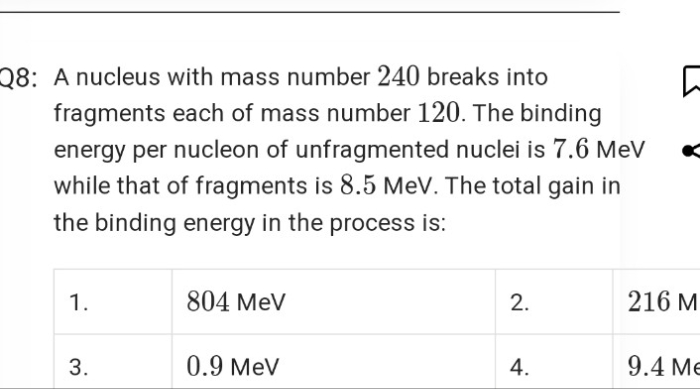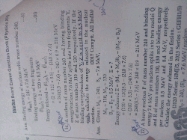CBSE Class 12-science Answered
Calculate the amount of energy released during the a decay of  Atomic mass of
Atomic mass of  = 238.05079 u
Atomic mass of
= 238.05079 u
Atomic mass of  = 234.04363 u
Atomic mass of
= 234.04363 u
Atomic mass of  = 4.00260 u
1u = 931.5 Me V/c2
Is this decay spontaneous? Give reason.
= 4.00260 u
1u = 931.5 Me V/c2
Is this decay spontaneous? Give reason.
 Atomic mass of
Atomic mass of  = 238.05079 u
Atomic mass of
= 238.05079 u
Atomic mass of  = 234.04363 u
Atomic mass of
= 234.04363 u
Atomic mass of  = 4.00260 u
1u = 931.5 Me V/c2
Is this decay spontaneous? Give reason.
= 4.00260 u
1u = 931.5 Me V/c2
Is this decay spontaneous? Give reason.
Asked by Topperlearning User | 02 Jun, 2015, 09:11: AM
The amount of energy released during a decay,
Q = 
Q = [238.05079 - 234.04363 - 4.00260] x 931.5 MeV
Q = 0.00456 x 931.5 = 4.25 MeV
No net energy is required for this reaction because energy is already produced by the conversion of lost mass energy. Because of this, the reaction is spontaneous.
Answered by | 02 Jun, 2015, 11:11: AM
CBSE 12-science - Physics
Asked by murshidibrahimkk | 08 Feb, 2024, 10:28: AM
CBSE 12-science - Physics
Asked by kailasks2007 | 28 Dec, 2023, 20:14: PM
CBSE 12-science - Physics
Asked by varma.renu9481 | 06 Mar, 2023, 17:44: PM
CBSE 12-science - Physics
Asked by Topperlearning User | 04 Jun, 2014, 13:23: PM
CBSE 12-science - Physics
Asked by Topperlearning User | 02 Jun, 2015, 13:03: PM
CBSE 12-science - Physics
Asked by Topperlearning User | 02 Jun, 2015, 10:23: AM
CBSE 12-science - Physics
Asked by Topperlearning User | 04 Jun, 2014, 13:23: PM
CBSE 12-science - Physics
Asked by Topperlearning User | 04 Jun, 2014, 13:23: PM
CBSE 12-science - Physics
Asked by Topperlearning User | 04 Jun, 2014, 13:23: PM
CBSE 12-science - Physics
Asked by Topperlearning User | 09 Jul, 2014, 12:48: PM



 nucleus with subsequent emission of
nucleus with subsequent emission of  - particle Write the corresponding nuclear reaction. Calculate the energy released in this reaction.
Given mass of 3 L
- particle Write the corresponding nuclear reaction. Calculate the energy released in this reaction.
Given mass of 3 L e = 4.000 26044 a.m.u.
Mass of neutron
e = 4.000 26044 a.m.u.
Mass of neutron  = 1.0086654 a.m.u.
Mass of tritium
= 1.0086654 a.m.u.
Mass of tritium  = 3.016049 a.m.u.
= 3.016049 a.m.u.
 undergoes β- decay and becomes
undergoes β- decay and becomes  , Calculate the maximum kinetic energy of electrons emitted assuming that the daughter nucleus and anti- neutrino carry negligible kinetic energy.
, Calculate the maximum kinetic energy of electrons emitted assuming that the daughter nucleus and anti- neutrino carry negligible kinetic energy.

